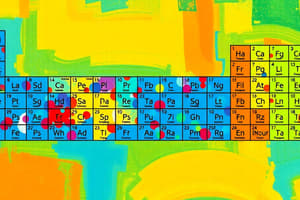Podcast
Questions and Answers
What term describes elements with similar electron configurations in their outer shells?
What term describes elements with similar electron configurations in their outer shells?
- Ionization energy
- Periodic trends
- Groups (correct)
- Valence electrons
Which trend explains the decrease in atomic size as you move down a column in the periodic table?
Which trend explains the decrease in atomic size as you move down a column in the periodic table?
- Reactivity
- Atomic size (correct)
- Ionization energy
- Melting point
What happens to the ionization energy as alkali metals gain another electron to fill their inner shell?
What happens to the ionization energy as alkali metals gain another electron to fill their inner shell?
- It remains constant
- It decreases
- It increases (correct)
- It becomes negative
Which group of elements in the periodic table typically exhibits an increase in reactivity from top to bottom?
Which group of elements in the periodic table typically exhibits an increase in reactivity from top to bottom?
How many valence electrons do elements in group 17 of the periodic table typically have?
How many valence electrons do elements in group 17 of the periodic table typically have?
What is the primary purpose of the periodic table?
What is the primary purpose of the periodic table?
How are elements arranged in the periodic table?
How are elements arranged in the periodic table?
Which property is shared by elements in the same group?
Which property is shared by elements in the same group?
What are the characteristics of noble gases?
What are the characteristics of noble gases?
Which statement about periodic trends is correct?
Which statement about periodic trends is correct?
Flashcards are hidden until you start studying
Study Notes
Introduction
The periodic table is a fundamental tool used by chemists to organize and understand the behavior of elements. It displays all known elements, their atomic numbers, atomic symbols, and many other properties. This article will explore how the periodic table classifies groups, organizes itself, exhibits periodic trends, and defines valence electrons.
Group Classification and Organization
Group classification helps us identify common characteristics among elements within a particular group. There are several ways to classify elements into groups based on their physical and chemical properties, such as metalloids, metals, nonmetals, and noble gases. Metalloids are elements with properties between those of metals and nonmetals. Metals have lustrous appearance, good conductivity, and high thermal conductivity and are generally more reactive than nonmetals. Nonmetals are poor conductors, opaque, and undergo oxidation easily when exposed to air. Noble gases share the property of being colorless, odorless, tasteless, nonflammable, unreactive gases. They usually have six outermost electrons.
Organizationally, the periodic table arranges elements in rows called periods and columns called groups. Elements within the same period have similar electron configurations, while elements within the same group have a similar number of valence electrons. Periods increase from left to right, and each period represents an additional energy level containing one more shell. Groups, on the other hand, contain elements with similar electron configurations in their outer shells. For example, the first two periods (one row) form the s-block, which includes alkali metals and alkaline earth metals, followed by p-block, d-block, and f-block groups.
Periodic Trends
Periodic trends are observable patterns in the properties of elements across different groups in the periodic table. These trends can be explained by the arrangement of electrons and electron transitions between energy levels. Some of these trends include:
- Atomic size: As you move down the column, atomic sizes tend to decrease because fewer electrons need to occupy the inner core of nucleus, resulting in smaller nuclear shielding.
- Ionization energy: As alkali metals gain another electron to fill its inner shell, they become less stable, requiring a higher energy input to remove an electron.
- Electronegativity: As you move down the columns, electronegativities generally decrease.
- Reactivity: Typically, the reactivity increases from top to bottom of the group. A metal becomes less reactive as it moves toward the end of the group.
- Melting point: Generally, as atomic size decreases, melting points increase.
These trends provide insights into how elements interact with each other and predict their behavior in various conditions.
Valence Electrons
Valence electrons are the outermost electrons in the electronic configuration of an atom, which determine the element's bonding capacity and interactions with other atoms. In simple terms, valence electrons are the ones involved in forming bonds with other atoms.
In the periodic table, the valence electron count is often indicated by the Roman numeral after the element symbol. This number corresponds to the group a particular element belongs to. For example, potassium (K), sodium (Na), lithium (Li) belong to group 1 of the periodic table, indicating a single valence electron. Similarly, carbon (C), nitrogen (N), oxygen (O), and fluorine (F) belonging to group 17 have seven valence electrons.
Understanding the periodic table and its concepts like group classification, periodic table organization, periodic trends, and valence electrons plays a vital role in understanding the chemistry behind everyday phenomena and helps us develop new materials and technologies.
Studying That Suits You
Use AI to generate personalized quizzes and flashcards to suit your learning preferences.




